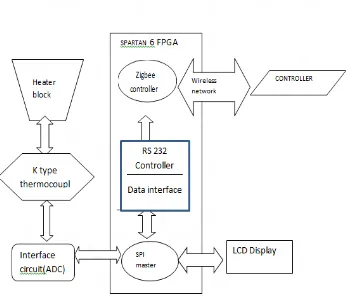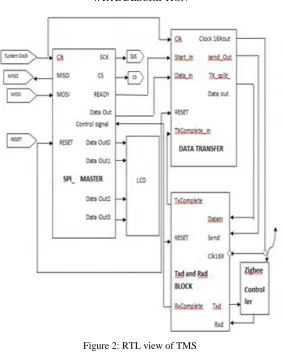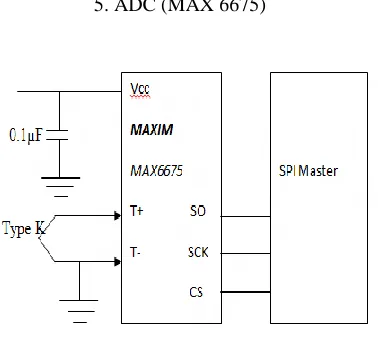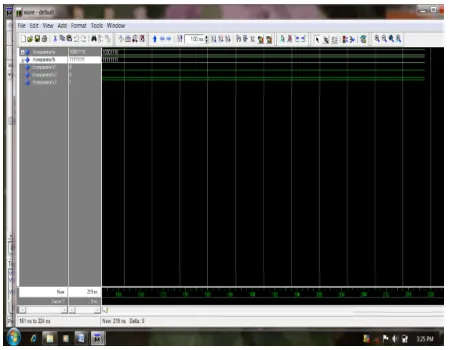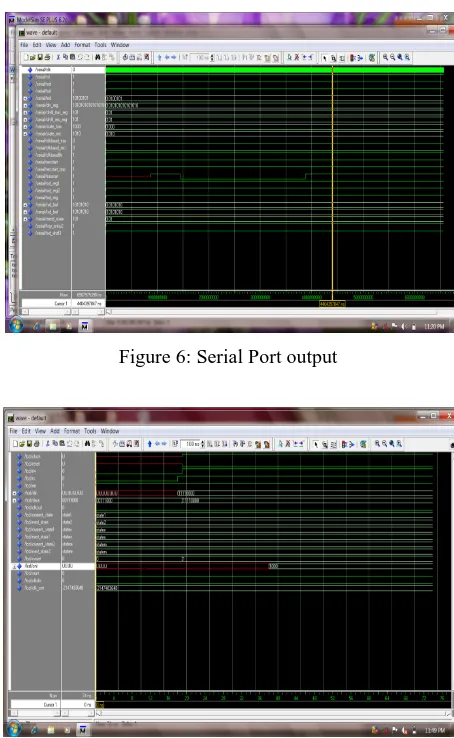Available Online at www.ijcsmc.com
International Journal of Computer Science and Mobile Computing
A Monthly Journal of Computer Science and Information Technology
ISSN 2320–088X
IJCSMC, Vol. 4, Issue. 12, December 2015, pg.8 – 14
Wireless Reprogrammable Real Time
Remote Temperature Measurement System
AMUTHA A, KARPAKAM S
Assistant Professor, Department of Electronics and Communication engineering,
SVS College of engineering, Coimbatore (Email: amuthastar@gmail.com)
Abstract—Wireless re-programmable real time remote temperature measurement system is able to measure the real time temperature of various remote locations with an accuracy of 0.25°C each. The existing methods use wire transmission. Hence if fault occur means, cable replacement cost is high. The proposed system uses wireless transmission (Zigbee) with the data rate of 256Kbytes/s, to transmit the measured temperatures to the central control system for monitoring purpose. In addition, the proposed system incorporates feature that controls the temperature at the remote locations in real time. Because of using Zigbee, this system effectively works for a distance of more than 60m between the temperature measurement locations and the control station and also its performance when compared to Bluetooth is high. Since this proposed system uses a reprogrammable controller, it is possible to customize the design to various industrial applications.
Keywords—Zigbee, FPGA, MAX6675, very high speed integrated circuit hardware description language, temperature.
1. INTRODUCTION
Temperature measurement system is very important to monitor the temperature in hostile industries, warehouse and containers. All such industries essentially require a system that measures the temperature accurately and then effectively transmit the measured temperature to the control room to monitor and control the temperature. Such a system should be efficient enough to improve energy efficiency and quality.
Researchers have developed many efficient temperature measurement systems. One such real time temperature measurement system for semiconductor devices uses a microcontroller and parallel wire communication for the data transmission. Another one method uses an opto-electronic instrument for measuring the temperature. A temperature measurement and control system using FPGA and wired serial communication for the data transmission was developed [9].
common controller in the remote location receives measured temperatures for monitoring the temperature. It also broadcasts the necessary control signal to the appropriate temperature measurement station (TMS). Each of the TMS has the proposed system that has been designed using the Very High Speed Integrated Circuit Hardware Description Language (VHDL) and implemented on an FPGA.
2. OVERVIEW BLOCK DIAGRAM
Figure 1: Overview Block diagram of TMS
3. BLOCK DIAGRAM DESCRIPTION
4. RTL DESCRIPTION
Figure 2: RTL view of TMS
The Register Transfer Level (RTL) for temperature measurement system essentially consists of five blocks and they are SPI_MASTER block, data transfer block, TXD and RXD block, Zigbee controller block and display block. The SPI block that works as a SPI master controller receives the temperature data from SPI slave, the MAX6675 chip, by initiating and synchronizing the serial transfer with the slaves using Chip Select (CS) and Serial Clock (SCK) signals. The frequency of SCK is kept at 3.125 MHz and that is derived from the 50MHz clock and that is less than the maximum frequency (4.3 MHz) to which the slave device supports. In order to read the data from the slave, first CS must be held high for 220ms that is the conversion period for the slave and then CS must be held low for 16 SCK clock cycles, during this period the data is read in the SPI master. In addition, the SPI master has been designed to measure the temperature for every500ms.
While the received temperature data has 16 bits, only12 bits (14 to 3) of the data contain the temperature information and that is directly displayed using display controller on seven segments displays. On the other hand the 12bit data is split in to two 8bits in the data transfer block by concatenating with four dummy bits. This ensures that each data to be transmitted by the RS232 controller has eight bits data width. The transmitter block TXD of the RS232 controller is operating at 115 kHz, which transmits the data serially to the Zigbee controller block, from where the data is transmitted to the controller wirelessly. At the control station, the data is received by the Zigbee receiver and it feeds the data to a GUI which is developed in such a way to receive the data from the various TMSs and uses it to plot necessary graphs required for monitoring the temperatures.
the heater. The power state of the heater remains as such until it receives the power on signal from the remote controller. To obtain a high data sampling rate the sampling clock of the TXD and RXD block is sampled 16 times the baud rate (Clock16x) which would be 1,843,200 Hz.
5. ADC (MAX 6675)
Figure 3: ADC (MAX 6675)
The temperature of the system is converted into corresponding analog voltage by K type thermocouple [4]. Then an analog to digital (A/D) converter MAX6675 converts the analog data to the digital data [6]. In addition, this converter resolves temperature to 0.25°Cand reads the temperature as high as +1024°C and gives its output to SPI master through SCK, SO and CS pins.
6. ZIGBEE
The wireless networking standard aimed at remote control and sensor applications which are suitable for operation in harsh radio environments and in isolated locations is zigbee. It defines the application and security layer specifications enabling interoperability between products from different manufacturers. The superset of the 802.15.4 specification is Zigbee.
The 802.15.4 standard is primarily aiming at monitoring and control applications. The most important feature is low power consumption that makes battery operated devices operating for a long time. The distance between 2 nodes can be up to 50 meters but be aware the each node can relay data to the next making a very big network, covering significant distances, possible.
ZigBee is known because of its mesh network architecture. It also supports star topology or hybrid or cluster tree architecture. Each type of topology has its own advantages and disadvantages depending on the application or situation. In star topology all the nodes directly communicate with one central node. The mesh topology is more complicated, each node may communicate with any other node within range. It's easy to understand that this gives many possible routes through the networks. This makes it a very robust topology because bad performing routes can be ignored. The cluster tree topology is the combination of star and mesh topology.
6.1Comparison between Bluetooth and Zigbee
Table 1: Comparison between Bluetooth and Zigbee
Market Name ZigBee Bluetooth
Standard 802.15.4 802.15.1
Purpose Monitoring & Control
Battery Life
(Days) 100-1,000+ 7 months
Network Size Unlimited (264) 7
Transmission
Range (Meters) 1-100+ 1-10+
Success Metrics Reliability, Power, Cost
Cost, Convenience
7. RESULTS AND DISCUSSIONS
Figure 4: ADC output
In the above figure the analog data received from the thermocouple is converted in to digital form. It is then given to the comparator for comparison process.
The comparator compares the digital value obtained from ADC is compared with a threshold value and makes decision. ADC output is given to LCD through SPI. The serial port output and LCD output are shown below.
Figure 6: Serial Port output
Figure 7: LCD Output
8. CONCLUSION
Thus, wireless temperature measurement system is capable of measuring temperature at a distance of more than 60m away from the control station and with an accuracy of 0.25°C. More over temperatures are measured in the interval of 500ms. Since the temperature controller was designed using VHDL which has been implemented in FPGA gives flexibility to further enhance the design and realize it in hardware rapidly. Thus it is believed that this system is suitable for hostile industries. Although many temperature measurement systems are commercially available, it provides an alternative cost effective solution.
REFERENCES
[1] T.Nandha Kumar, T.M.A.K AL Saleh, SRS.Prabaharan, Haider.F. Mohamed, “An FPGA Based Temperature Controller for Differential Thermal Analyzer” Proc. ICROS-SICE InternationalJoint Conference, 2009
[2]Wireless Temperature Monitoring System
http://www.pultronics.com/en/ds/Temperature%20Monitoring%20System_short_003.pdf
[4] Measuring Temperature with Thermocouple,
http://www.datataker.com/Datalogger_Manual/Measuring%20Temperature%20wiwi%20Thermocouples.htm
[5]MAX6675 Datasheet, http://www.sparkfun.com/ datasheets/ IC/ MAX6675.pdf
[6] Shan, Q & Brown, D, “Wireless Temperature Sensor Using Bluetooth”, http://www.ctr. kcl.ac.uk/iwwan2005
[7]Measuring Temperature with Thermocouple,
http://www.datataker.com/Datalogger_Manual/Measuring%20Temperature%20wiwi%20Thermocouples.htm
[8]MAX6675 Datasheet, http://www.sparkfun.com/ datasheets/ IC/ MAX6675.pdf
[9] T. Nandha Kumar, Haider A. F.Mohamed, B.A.C.M. Naleem and V. Ganeish “An FPGA based real time remote temperature measurement system”
